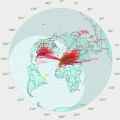rx.linkfanel.net receiver map moving to Leaflet
Due to increased traffic, the new pricing practices of Google Maps had finally caught up with us with the new year, hence the pesky "For development purposes only" dark overlay you may have noticed on the map for more than a month now. We've taken this opportunity to make several updates and improvements, including alternative support for the Leaflet API.
We hope to bring you a better experience, especially on mobile. If you encounter any new issue with the transition to the new map, or have any other feedback, please let me know and I will try to look into it.
Thanks to jks for his help and support in setting this up!
http://rx.linkfanel.net/
Which improvements would you like to see added to the map?
We hope to bring you a better experience, especially on mobile. If you encounter any new issue with the transition to the new map, or have any other feedback, please let me know and I will try to look into it.
Thanks to jks for his help and support in setting this up!
http://rx.linkfanel.net/
Which improvements would you like to see added to the map?




Comments
Note that map tiles for Leaflet are now served by the same provider used by the TDoA extension and admin page GPS tab maps. This means KiwiSDR is paying for those tile serves out of the profits from selling KiwiSDRs (same as we do for the charges incurred in running the proxy service).
Please add terminator line and cookie support for map settings...
For example if I use map layout I need choose it after any refresh.
Thanks for doing this, it's much appreciated.
I find the S/N map and rating list extremely useful, especially when trying to optimise my own KiWi's and also when trying to find KiWi's that are suitable for TDoA purposes. In fact it would be really useful if the TDoA Kiwi selection map could somehow indicate the S/N ratings of each in order to make the selection process quicker by ruling out KiWi's with really bad (unusable) S/N values.
I'm not sure how frequently the S/N values on http://rx.linkfanel.net/snr.html are updated, but maybe an 'average' and 'recent' display would be worthwhile additions ?
I must admit I'm biased about this as I believe that across the whole 0 - 32MHz spectrum, my KiWi http://southwest.ddns.net:8073/ is probably in the top 3 worldwide, although it's currently sitting at number 23 on the list with a S/N of 31.72 dB.
However when I have actually examined the spectrum display or performed an 'auto scale' test with the spectrum fully zoomed out I get better results (currently auto scaled as -22 to -114dB) than other KiWi's that are higher up on the list.
Its main competitors (by manual examination of the spectrum display of each) are http://nsk.proxy.kiwisdr.com:8073/ with a listed value of 40.35 dB (currently auto scaled as -17 to -115dB) and http://kphsdr.com:8073/ with a listed value of 32.79 dB (currently auto scaled as -35 to -118dB). All the rest I have currently tried in the top 20 on the list are worse performers, but it does depend to a certain extent on local time at the KiWi and propagation conditions.
Obviously the derived S/N values are not that accurate, as the percentile of power levels across the whole spectrum (signal), and the median power level (noise) depend upon the distribution of signals across the spectrum, how they are filtered and what unwanted noise is present that may seem like a valid signal. However despite these limitations, the S/N map is still the best way I've found to quickly sort out the really bad performers.
It's a pity that the http://sibamanna.duckdns.org/sdr_map.html map is no longer functioning, as that (at my suggestion) was modified to split the frequency range into several different blocks of spectrum, and gave average and current values for each, which provided a better overview of the likely performance, especially if you were interested in a specific frequency range.
I'm not sure how you can actually improve the S/N calculation without a very large amount of effort, but splitting it into bands and taking measurements at the same local time for each KiWi, may help improve the resolution.
Regards,
Martin - G8JNJ
Also, some of the 'top' antenna scores are terrible setups, at least across the entire Kiwi spectrum. Many are overloaded and biased in one area and dead in other areas, they are not balanced performers at all. perhaps this is a metric that only the ear can discern?
What might be more useful is just trying to ID overall "bad" KiwiSDR setups. Those with poor sensitivity everywhere, or massive RFI issues (also often everywhere). I keep a mental list of which receivers to avoid overall, as well as which perform well on certain bands.
I agree that "average" and "recent" are both valid approaches though. At this point I favor the one that puts less constraints on me and the infrastructure. As I mentioned above with TDoA, different approaches are best suited with different use cases in mind, so improving quality metrics goes hand in hand with developing new ways to use them.
Relative to that topic, is there any how-to, guide or documentation anywhere to improving and tuning reception quality on your KiwiSDR?
I do not think there is anything in one spot. There are many excellent posts here in this forum. Here's a summary of my experiences:
"The alternative would be to make the color gradient bi-dimensional, or somehow cram more information into the marker while keeping it uncluttered and visually straightforward..."
Maybe just a very crude indicator would be good enough and perhaps an incentive for KiWi admins to try and improve their 'rating'.
A 'traffic light' colour scheme (or similar) would perhaps help.
Red = <10dB
Orange = >10dB / <20dB
Yellow = >20dB /<30dB
Green = >30dB
Any KiWi's scoring less than 10dB definitely have a problem regardless of the merits of the existing auto scale measurement system :-(
The main issue with the current auto scale system is not so much the level of the strongest signals, but differentiating between noise and genuine signals in order to determine the noise floor. One way around this may be to sample a selection (in case a good signal just happens to be present on one) known 'quiet' frequencies in groups that are adjacent to each other (to test if the measurements are consistent, or if the noise consists of spectral lines) to build up a better idea of the noise floor in a few different segments of the spectrum. This could then be tested against ITU graphs to see if they follow the correct trend. It may even be possible to use this as another quality score, perhaps by measuring day / night variations, as I have found the variation in wsprdaemon S/N graphs give a good indication of the performance on each band by the individual KiWi's who are reporting
Regards,
Martin - G8JNJ
These are relatively clear.
http://kiwi.farnham-sdr.com:8073/?f=6z12
http://kiwi.farnham-sdr.com:8073/?f=116z12
http://kiwi.farnham-sdr.com:8073/?f=2010z12
http://kiwi.farnham-sdr.com:8073/?f=5070z12
http://kiwi.farnham-sdr.com:8073/?f=10044z12
http://kiwi.farnham-sdr.com:8073/?f=15080z12
http://kiwi.farnham-sdr.com:8073/?f=20300z12
http://kiwi.farnham-sdr.com:8073/?f=25500z12
http://kiwi.farnham-sdr.com:8073/?f=25500z12
http://kiwi.farnham-sdr.com:8073/?f=29980z12
Alternatively split it into something like 4MHz wide chunks and perform an auto scale on each.
This is my moderate performing KiWi which is just about useable, but has quite a lot of noise.
First the wideband auto scale taken at midday local time.
http://kiwi.farnham-sdr.com:8073/?f=15000z0 -34 / -100
Next the individual groups of bands.
http://kiwi.farnham-sdr.com:8073/?f=2000z3 -37 / -100
http://kiwi.farnham-sdr.com:8073/?f=6000z3 -58 / - 115
http://kiwi.farnham-sdr.com:8073/?f=8000z3 -59 / -112
http://kiwi.farnham-sdr.com:8073/?f=12000z3 -58 / -113
http://kiwi.farnham-sdr.com:8073/?f=16000z3 -44 / -110
http://kiwi.farnham-sdr.com:8073/?f=20000z3 -57 / -107
http://kiwi.farnham-sdr.com:8073/?f=24000z3 -54 / -106
The minimum readings show the raised noise floor above 20MHz which I think is a reasonable interpretation of the spectrum.
Regards,
Martin - G8JNJ
The problem with Day / Night comparisons is interference from devices that are mainly used during the working day or solar PV.
A lot of interference is broadband in nature or has closely packed spectral components.
Measure the noise floor with a wide zoom setting say z3 and then measure it again on a 'quiet' frequency within the same frequecny range but zoomed in to z0, then compare the two values.
Regards,
Martin - G8JNJ
Would it be possible to include the auto scale max / min values and the difference between the two on the http://rx.linkfanel.net/snr.html page ?
I have noticed that in the top 30 many of the poorer performers have a minimum value of between -100 to -110dB whilst the better performers are generally -115 or lower.
This would seem to be because unwanted noise in the 20 - 30MHz spectrum (which is nearly always interference) raises the overall minimum value when auto scale is used.
If my theory is correct, I would hope that by showing these values it may indicate further trends and help indicate differences between the best and worst performers in each 'tier' of ranking.
Regards,
Martin - G8JNJ
I understand an average is more meaningful over a longer time, but something shorter could be useful too.
Thanks for asking for feedback!
Mark.
Note to sys ops, you should set and freq. range to reflect your RX's performance which is a product of antenna range and applied filters.
my kiwi does not appear on sibamanna and is listed on sdr.hu.
thank you
Ricardo
http://py4aaz.homeip.net:8073/
To be honest I didn't know it was back up.
I have emailed the guy in the past and he was quite helpful but I guess this is not something he gets enough payback to work on.